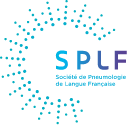Emphysema is characterized by alveolar destruction and usually caused by chronic cigarette smoke exposure. Once the lesions are constituted no spontaneous regeneration process occurs. Rosiglitazone, an agonist of the peroxisome proliferator-activated receptor g (PPARg) pathway, and T0901317, an agonist of the sterol regulatory element binding protein (SREBP) pathway, could restore cell stem niche properties through differentiation of fibroblasts into lipofibroblasts (LIF). The aim of our work was first to evaluate the number of LIF in lungs of patients with or without emphysema. Secondly, we aimed to evaluate if the activation of the PPARg pathway or SREBP pathway with Rosiglitazone and T0901317 respectively could induce alveolar regeneration in vitro and in vivo in a murine model of emphysema.
LIF quantification: Immunofluorescent staining was performed on human lung tissue slides to identify LIF (ADRP+Vimentin+). In vitro model: Human primary fibroblasts were treated with Rosiglitazone and T0901317. LIF phenotype acquisition was evaluated through ADRP IF staining. Stem cell niche properties were evaluated by performing alveolar organoid formation assay by co-culturing pre-treated fibroblasts with H-441 cells. In vivo model: Adult C57BL6 mice received intra-tracheal injection of either Elastase or PBS. From D21 mice were treated by intraperitoneal injections of Rosiglitazone (5μg/g/d), T0901317 (10μg/g/d) or vehicule, 5/7days. Lungs were collected at D90. Left lung was fixated for morphological analysis and right lung was digested for fibroblast isolation. Alveolar organoid formation assay was performed by co-culturing fibroblasts with epithelial cells.
LIF quantification: we confirmed the presence of LIF in the lung of adult patients but no difference in the number of LIF was observed between patients with or without emphysema. In vitro model: fibroblasts pre-treated with T0901317 presented a higher expression of ADRP and increased the number of alveolar organoids formed (P=0.018) but not those pre-treated with Rosiglitazone. In vivo model: at D90 we observed an increase in the number of alveoli assessed by the mean chord line (P=0.0012) in the Rosiglitazone treated group but not in the T0901317 treated group (P=0.084). No fibrosis was observed by measuring both septal thickness and Sirius red staining. Immunofluorescent staining of SFTPC+KRT8+ cells showed no increase in alveolar differentiation intermediate (ADI). Alveolar organoids formed with fibroblast from both T0901317 and Rosiglitazone treated mice were larger than those obtained from control fibroblasts (P=0.0032).
Activation of the SREBP pathway allowed reorientation of human fibroblasts towards a LIF phenotype and enhanced alveolar organoid formation in vitro. Activation of the PPARv pathway allowed alveolar regeneration without fibrosis in a murine model of emphysema.
Le texte complet de cet article est disponible en PDF.
© 2022
Publié par Elsevier Masson SAS.




